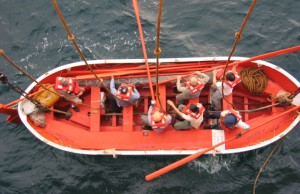By Peter Corney
Imagine a fourteenth century church which has a series of beautiful stained glass windows that tell the biblical story.
They begin on the south side of the nave near the entrance and font with a window that depicts Adam and Eve as the crown of God’s creation, their act of disobedience and their ejection from the garden. As we proceed along the south wall the windows continue the story. There is the flood and the ark and the rainbow of promise. Then we see the call of Abraham. Further along is a striking window of the young David, the future king slaying Goliath; and then on to the great Prophet Isaiah foretelling the coming of the eternal king the Messiah.
When we turn to the north side wall of the nave we begin with a nativity scene and then John the Baptist by the river Jordan with Christ coming to be baptized; then there is the healing of the blind man and then the Sermon on the Mount. As we approach the chancel steps the last window on the north side is of the last supper and betrayal by Judas.
Finally as we walk up through the chancel towards the sanctuary there on the east wall above the Holy Table is the powerful crucifixion widow with its red and blue – black glass with touches of translucent gold. It has a terrible beauty. The cross takes our eyes upwards to a triumphant mosaic of the risen and ascended Christ. Finally they reach the apex of the great arch in which is placed a circular window, or more correctly three intersecting circles. Each circle contains a symbol – a crown for God the Father, a lamb for God the Son and a dove for God the Holy Spirit. The light shining through the brilliant colors crowns the whole east end picture with a transcendent glow.
The whole is a magnificent artistic depiction of the great Judeo/Christian meta – narrative of creation, fall and redemption that interpret’s history, the future and reality; the story and the values on which Western culture has been constructed.
But a catastrophe is about to overtake this place. There is a great earthquake and the building is almost completely destroyed. Such is the magnitude of the shocks that every window is shattered, even the mosaic on the east wall is shaken free and destroyed.
If you were to approach the building now, although a ruin, its shape is still discernable, but the beautiful windows and mosaic lay shattered and scattered in a thousand fragments on the stone floor of the building.
Imagine visiting the site many years’ later, you see people picnicking on the grass nearby and a child sitting on the remains of the flagstone floor. As you come closer you see that she is playing with fragments of stained glass and mosaic that she has collected. She moves them in little random patterns of color and shape lost in her game unaware of the origin of the colored pieces in her game.
As you observe this scene you wonder how you could explain to her or her parents what all these fragments really mean, what they once represented. That is the challenge that Christians in the Post Modern West are now confronted with as they seek to evangelize their culture.
Jean Baudrillard, an influential writer on Post Modernism, describing the results of the deconstruction of all objective universals and norms says: “All that is left are the pieces. All that remains to be done is to play with the pieces. Playing with the pieces that is Post Modernism”*
(*Jean Baudrillard. Quoted in ‘Truth Decay’ by Douglas Groothuis. IVP 2000 p169)


